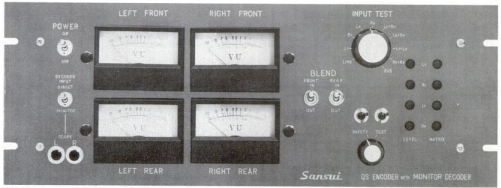
10-4-2024 VERSION 2.4a
 |
10-4-2024 VERSION 2.4a |
This list was created to document the quadraphonic Radio Broadcast that took place from 1969 to the early '80's. A few Bootleg records appeared over the years made from these broadcasts. You can always count on a tape deck rolling somewhere and this list might be most useful to tape traders that are willing to go to any length to get a recording of something they crave. Any information you might be able to pass on is appreciated, Magazine's from the era are a great source for this info since many quad radio broadcasts were advertised if the radio program had national distribution.
For additions to this list, include:
1. Artist 2. Date of Broadcast 3. Quadraphonic Format (Discrete, SQ, QS, Discrete) 4. Program name (King Biscuit, Etc.) 5. Country of origin (U.S., U.K., etc.) 8. Any comments that might be helpful.Please send any additions or corrections to this list to : * /|\ * Mark Anderson / | \ * multichannel AT cox DOT net * / | \ ------/ | \--------------- / | \ | This list can be accessed from : http://www.surrounddiscography.com/
During the quadraphonic era, there were hopes that radio broadcasts someday would be all multi-channel. To broadcast Quadraphonic was difficult and never actually came to a solution. One attempt to broadcast in quad was by using one radio station to broadcast the front channels while another broadcast the rear. In order to receive these "Discrete" broadcasts, a second stereo FM receiver was needed. This proved to be problematic since owning two stereo receivers was not a reality for most. The other method was to matrix the 4 channels to 2 and then decode the 2 channels back to 4 on your home receiver. There were suggestions to broadcast the extra channels by multiplexing them on a second subcarrier at 76 kHz. These designs were made by Zenith Corporation, General Electric, RCA and Dorren Quadracast Systems. There was never an agreement between the FCC and the EBU how to broadcast quadraphonic sound, but here in the U.S. The National Quadraphonic Radio Committee (NQRC) recommended the Quadracast system from Lou Dorren and was adopted by the FCC in 1983. Brad Miller was the only representative of the industry who wanted a discrete system, and CBS even proposed a USQ system that was compatible with Matrix SQ, yet had a discrete sub-carrier for optimal performance. They even developed a fully discrete Matrix system, but it never was really developed, although it was patented. The BBC was designing their H-matrix at the same time and they regarded it at that time as Quadraphonic. Live rock concerts were broadcast in matrixed Quadraphonic formats on syndicated shows like the "King Biscuit Flower Hour".Written By Eero Aro & Mark Anderson